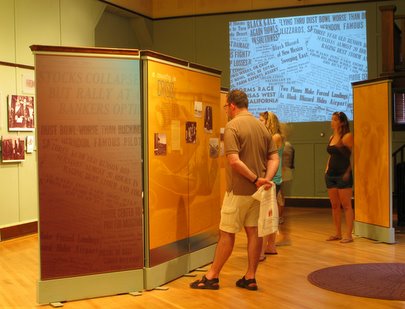|

Michael Quinn
Contact: Shannan Marcak, 928-638-7958 Grand Canyon, AZ. – Sunday, October 19, was the last day to view “It Saved My Life, the CCC at Grand Canyon, 1933 – 1942,” a highly successful, temporary exhibit that was developed for Grand Canyon National Park’s Kolb Studio. Visitor comments make it clear that the exhibition, intended to celebrate the 75th anniversary of the Civilian Conversation Corps (CCC) – a Depression-era program that was often credited with “saving my life” – made a big impression. The exhibit was a collaborative effort between the National Park Service (NPS) and the Grand Canyon Association (GCA), and was open for just 143 days. Yet in that time, almost 45,000 people from 38 countries and 49 of the 50 United States experienced it, many of them writing their comments and thoughts in log books provided so that people could share their impressions. Visitors regularly wrote about how much they learned, gaining a greater understanding of both the past and the power of people working together to solve problems. It was apparent that while the exhibit was originally developed to commemorate the CCC’s history at the Grand Canyon, for the viewing public, it celebrated the organization’s nationwide accomplishments in conservation and infrastructure development, and the program’s monumental achievement of providing hope to a nation in the grip of despair. “Very moving – gives those who did not experience such despair an idea of how hard it was and what a great help CCC, WPC, etc. were.” Linda from New Jersey. Often, people reminisced about family or friends who had been a part of the CCC: “I’ve heard my mother speak of her brothers being in the CCC in North Carolina, but I never realized the impact it had on their lives or how they supported their family.” June C. Other people shared how the CCC had impacted them, personally: “Not only did the CCC change my Dad’s life but through him it changed mine.” The Martin family. Even young people expressed a greater understanding and appreciation of the hardships and experiences that shaped past generations, perhaps as a result of their work on a limited edition, CCC Junior Ranger book developed to enhance a child’s experience of the exhibit. “Thanks for teaching me how hard it was years ago Now I understand why we are blessed”. 10-year-old from California. A large number of people also drew parallels between the past and the present, and expressed a sense of hope and inspiration after learning about the CCC legacy. “A great tribute to those with the ideas and courage to carry them out. Oh for such great ideas and courage today!” Unknown. “Our nation could learn a great deal from this exhibit…” Unknown. “…very apropos to today.” Unknown. “This is so inspiring and makes me feel the country…might profit from a program like this today.” Unknown. During tough economic times, hope and inspiration are not surprising responses to learning about a program that employed, trained and educated millions of young men while addressing a significant backlog of infrastructure and conservation projects in state and national parks, national forests and other public lands. In its short nine-year existence, the CCC employed approximately 3.5 million men whose pay checks are estimated to have benefitted 12 to 15 million people. Four government departments – labor , war, interior and agriculture – worked together to administer the program which eventually built 125,000 miles of road, raised 80,000 miles of phone lines, developed 800 state parks, restored almost 4,000 historic structures, planted over 2 billion trees and laid over 13,000 miles of trail, not to mention providing men with marketable skills such as masonry and rock-work and teaching over 40,000 illiterate men to read. Two of the greatest challenges facing any “museum exhibit” are finding ways to connect people to a past that, for many, is dead and gone, and making the exhibit relevant to today’s citizens. “Saving the Boys,…”, seems to have achieved both with seamless ease. With this exhibit, the NPS and GCA have helped people from all walks of life to not only understand an often overlooked aspect of American and conservation history, but have taught them about themselves in the process. “…a very interesting exhibition reflecting the hope and imaginative thinking we are all capable of but rarely surface until times of crisis.” Nicole from Scotland. Comments like these make it clear that the words of a couple from Yuma, Arizona, could easily be applied to the exhibit’s creators, not just to the CCC: “…our hearts well up with pride for these unsung heros. What an incredible story.” We commend Historian Michael Anderson; GCA consultant Pam Frazier; Grand Canyon National Park Rangers Pam Cox, James Schenck, and Bob Audretsch; the Grand Canyon Association and the National Park Service for sharing it. While the exhibit has closed at Grand Canyon National Park, it has been packed for transport as a traveling exhibit at the urging of local communities. To learn more about where the exhibit might be available in future or for information about showing the exhibit, please contact Park Ranger James Schenck at James_Schenck@nps.gov. For more information about the CCC at Grand Canyon or for information on visiting Grand Canyon National Park, please go to the park’s web site at www.nps.gov/grca. -NPS- |
Last updated: December 20, 2017
